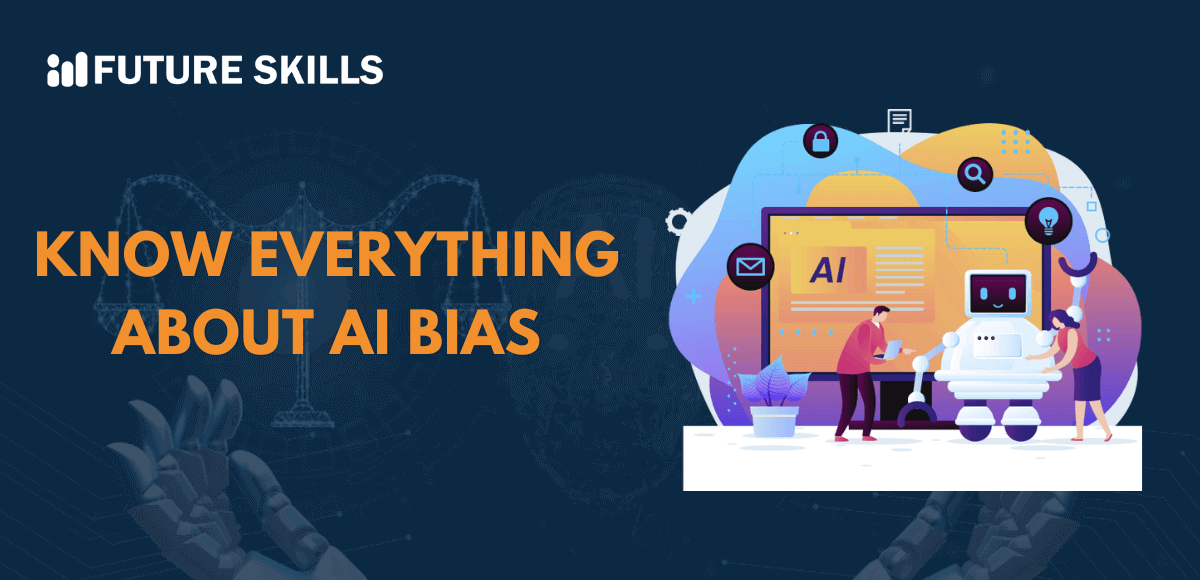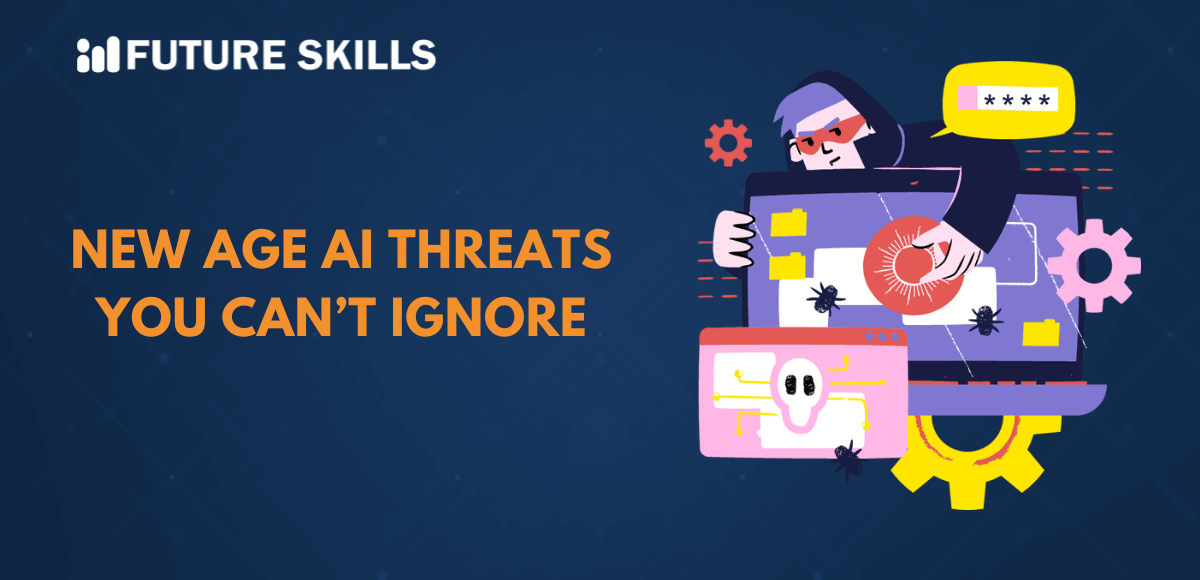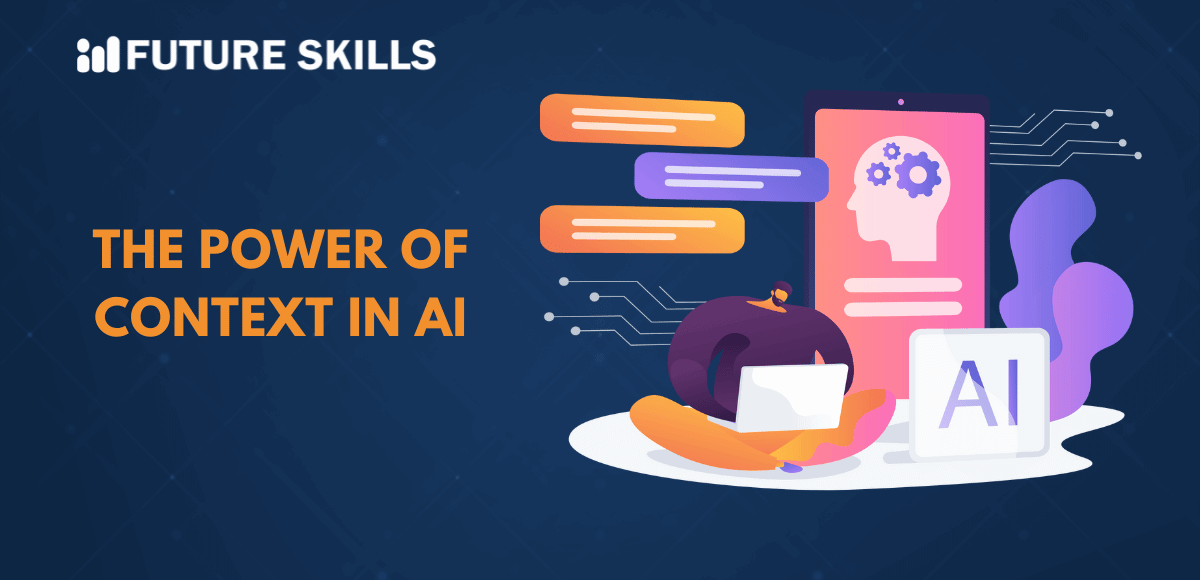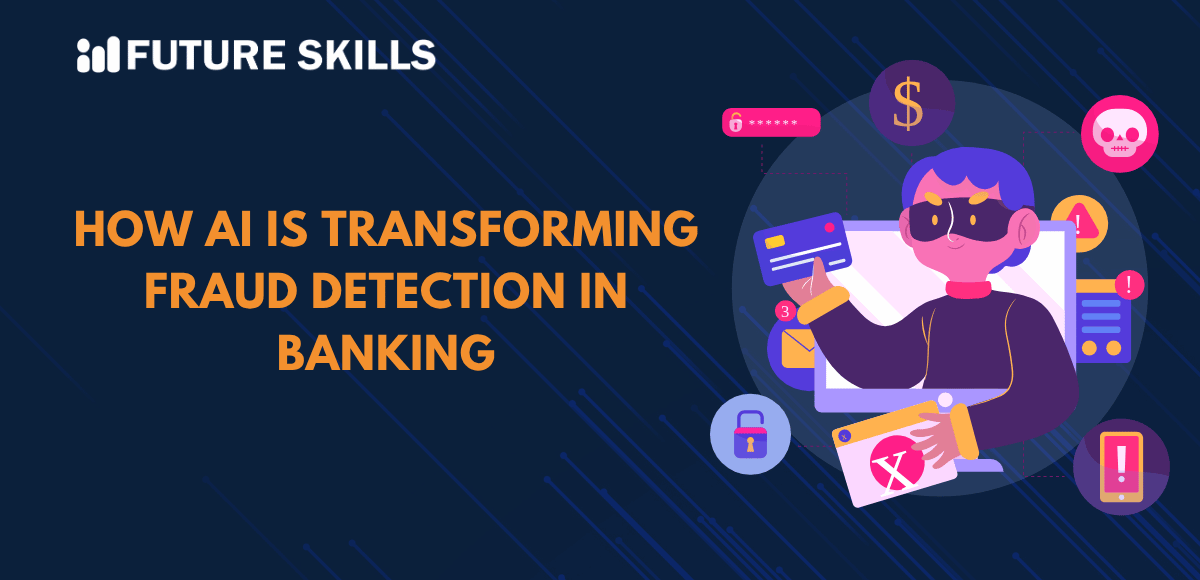Artificial intelligence is a major trend in the field of technology and has revolutionized various industries. Therefore, businesses and the general public have been expressing their interest in the benefits of artificial intelligence for different applications. On the other hand, there are many concerns regarding the types of AI bias and their impact on users.
The credibility of the outputs of AI systems is subject to problems due to the biases in the training data. Therefore, it is important to understand AI bias and its impact on the effectiveness of AI systems. Let us learn more about AI bias, its different variants, examples of AI bias, and ways to resolve it through this comprehensive AI bias guide.
Embark on a transformative journey into AI, unlocking career-boosting superpowers through our Certified AI Professional (CAIP)™ Certification program.
What is Bias in AI Systems?
Bias in AI systems draws attention to AI systems that generate results that have elements of human biases visible in society, such as social inequality or historical biases. The answers to “What is AI bias?” primarily reflect on the origins of bias in AI systems. The initial training data and even the predictions produced by an AI algorithm can serve as the potential origins of artificial intelligence bias.
Companies have been seeking new ways to embrace artificial intelligence in their operations. However, the growing adoption of AI systems has led to the need for an AI bias guide to identify the types of human biases that have entered AI systems. The threat of AI bias is evident in the use of discriminatory data in the training of AI models that can amplify the negative effects of AI. Businesses can leverage opportunities to address the challenges of bias to achieve better productivity alongside fairness in AI systems.
Build ChatGPT skills and take the first step to becoming superhuman with our free ChatGPT and AI Fundamental Course
What are the Common Sources of Bias in AI Systems?
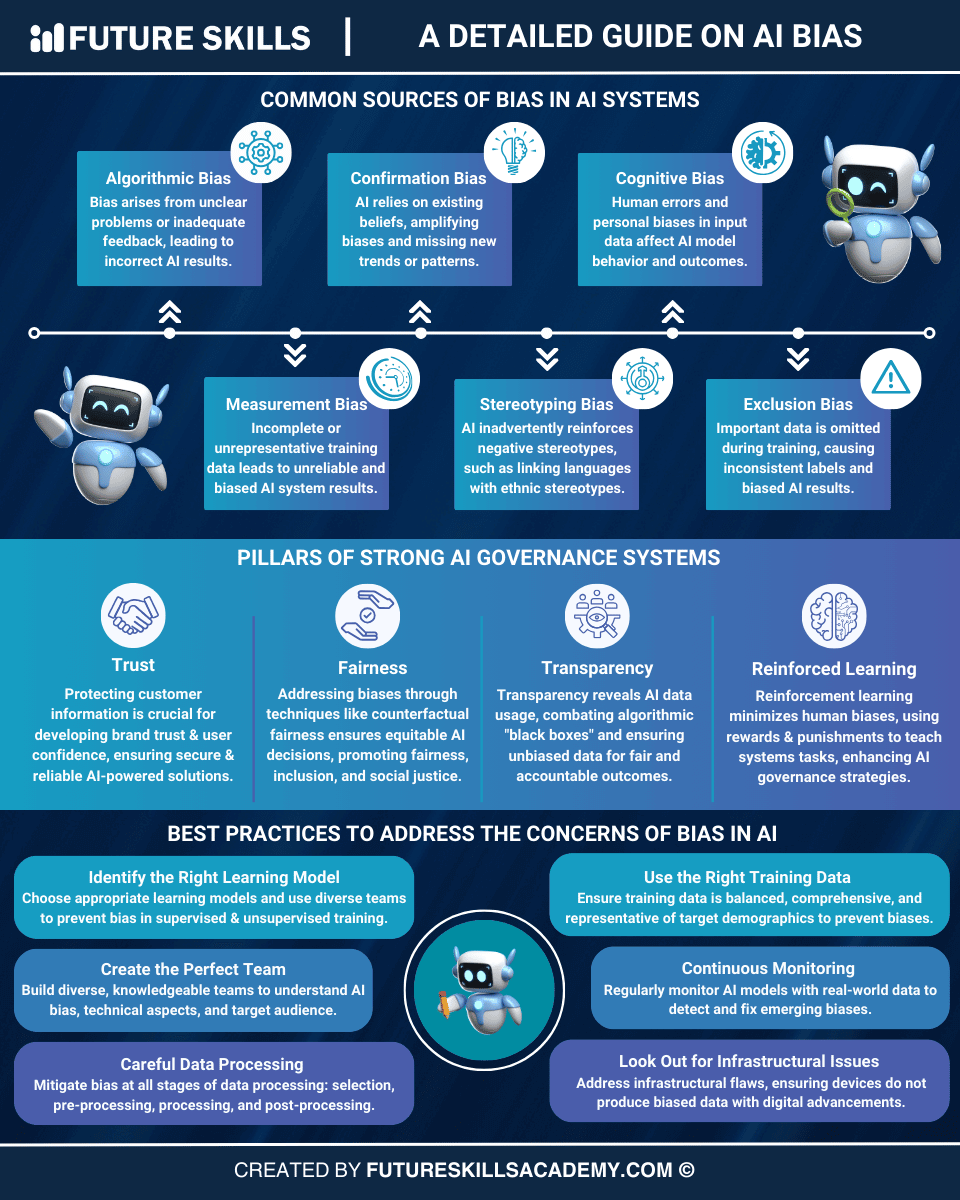
The ideal approach for resolving bias in AI systems involves diving deeper into the details of the origins of AI bias. It is the best way to learn AI bias and its broader implications for the future of artificial intelligence. Biased results by AI systems can lead to formidable issues for organizations and society. Here is an outline of some of the most common sources of bias in AI systems.
-
Algorithmic Bias
AI systems can offer a biased result or misinformation when the problem or the question is not completely specific or correct. Algorithmic bias also emerges from inadequate feedback to a machine learning algorithm that does not guide it to the right solution.
-
Confirmation Bias
Another prominent addition among AI bias examples is confirmation bias, which results from excessive dependence on pre-existing beliefs or data trends. As a result, confirmation bias can amplify the impact of bias and lead to an inability to identify new trends or patterns.
-
Cognitive Bias
AI systems work by using human input. It is important to note that humans are vulnerable to error, and personal bias could find its way into users’ queries. Personal bias can affect the model behavior or dataset directly, thereby creating more possibilities for confirmation bias.
-
Measurement Bias
Incomplete data is another important factor responsible for measurement bias. Questions such as “What is AI bias?” revolve around the importance of training data. Without adequate preparation or lack of oversight, the dataset might not represent the broader sample. One of the common examples of measurement bias is sample or selection bias, which emerges from the small size of the machine learning model. If the training data is incomplete, then it is less likely to expect the best results from the AI systems.
-
Stereotyping Bias
Stereotyping bias is an inadvertent phenomenon when AI systems reinforce negative stereotypes. For example, natural language translation systems can relate certain languages with specific ethnic stereotypes and genders. The problem with removal of data featuring certain labels to avoid stereotyping bias is the reduced accuracy of results by AI systems.
-
Exclusion Bias
Exclusion bias is one of the commonly overlooked highlights in any AI bias guide for beginners. Developers might fail to consider certain factors when training the AI models and leave important data from the training data set. It can also lead to recall bias that involves inconsistent application of labels through subjective observations.
Enroll now in the AI for Business Course to understand the role and benefits of AI in business and the integration of AI in business.
What are the Principles Recommended to Avoid Bias in AI Systems?
The principles to avoid bias in AI systems are the foremost requirement for any AI developer to create effective AI systems. You can learn AI bias principles and use them as the first line of defense against threats due to bias in AI systems. The first step in avoiding bias in AI systems is to look twice before deployment. Just like other business challenges, the problems of bias in AI models must be addressed from the beginning. It can help in avoiding detrimental consequences of bias in the long run.
Another important requirement to address concerns about AI bias is AI governance. Organizations must encourage awareness of “What is AI bias?” and initiatives to help business teams specialize in the supervision and management of AI activities. AI governance involves development of a set of policies, frameworks, and practices that can encourage the responsible development and implementation of AI technologies. It can serve as the best factor for achieving a balance of benefits for businesses, society, employees, and customers.
The effective implementation of AI governance can help in assessment of inclusion, fairness, and equity. Transparency and fairness ensure that unbiased data is used to develop AI systems with the assurance of accurate results. Furthermore, a ‘human-in-the-loop’ system can introduce the option for making recommendations that involve human decisions.
What are the Pillars of Strong AI Governance Systems?
AI governance is more than just a concept on paper. Businesses can address different types of AI bias by learning about the important practices for AI governance. AI governance policies would revolve around the significance of the following pillars.
-
Trust
AI systems must safeguard customer’s information to develop brand trust and gain the trust of users.
-
Fairness
The review of AI bias examples also showcases that AI governance can provide methods for assessment of inclusion, fairness, and equity. Some of the approaches, such as counterfactual fairness, help identify bias in the decisions of a model and ensure equitable results.
-
Transparency
Another critical factor in AI governance practices refers to transparency, which helps in exploring more insights into data used for creating AI systems. Generally, AI algorithms work as black box systems without any way to find data that helps the AI systems make certain decisions. Transparency in AI governance could help in ensuring the use of unbiased data to ensure fair results.
-
Reinforced Learning
AI governance also relies on best practices for reinforced learning, an unsupervised learning technique. It is an important part of any AI bias guide on governance as the technique leverages rewards and punishments to teach a specific system how to accomplish certain tasks. Reinforcement learning crosses the borders of human biases and can lead to the development of new strategies for reducing AI bias.
What are the Best Practices to Address the Concerns of Bias in AI?
The negative impact of AI bias can have a massive influence on the prospects for adoption of AI systems in the long run. Therefore, it is important to abide by the following best practices to deal with the problems due to AI bias.
-
Identify the Right Learning Model
The foremost practice in developing bias-free AI systems is the identification of the right learning models. The difference in types of learning models can lead to the development of different types of AI bias due to the differences in approaches. Supervised training models involve stakeholders selecting the training data. Therefore, the stakeholder team should be diverse and should know the techniques to avoid unconscious bias. On the other hand, unsupervised training models can use AI itself through bias prevention tools to recognize bias.
-
Use the Right Training Data
The selection of the best learning model for AI systems is only one part of the overall process of addressing bias. Faults in the training data would be reflected in the output of AI systems. Therefore, the data entered into AI systems should be balanced and comprehensive and must showcase an accurate representation of the demographics of the group in question.
-
Create the Perfect Team
The definition of a perfect team for AI development projects varies according to the project goals. You would need professionals with knowledge of concepts beyond “What is AI bias?” and the technical aspects of AI system implementation. The diversity of talent in your AI team can help you improve your chances of recognizing bias. Furthermore, you must have professionals who can understand the target audience of the AI solution and your goals.
-
Careful Data Processing
Businesses should pay attention to possibility of presence of bias at each step of data processing. Data selection is only one of the factors that lead to bias in AI systems. However, bias can enter AI systems in the pre-processing, post-processing, and during the processing stages of data for AI training.
-
Continuous Monitoring
One of the best practices recommended for anyone who wants to learn AI bias focuses on continuous monitoring. As the AI landscape evolves and models adapt to new trends, new types of bias can find their way into these systems. It is important to monitor and test AI models consistently with real-world data to identify and resolve the problems of bias before they lead to harm. The ideal approach for continuous monitoring to reduce AI bias is the selection of an independent team or audit firm.
-
Look Out for Infrastructural Issues
Apart from the influence of human and data errors, infrastructural discrepancies can also lead to bias in AI systems. Data collected from faulty devices could lead to biased data, thereby creating issues in the long run. With the help of latest digital advancements, you can address the problems of bias due to infrastructural issues.
Excited to understand the crucial requirements for developing responsible AI and the implications of privacy and security in AI, Enroll now in the Ethics of Artificial Intelligence (AI) Course.
How Does AI Bias Play Out in Real Life?
You must be wondering about the reasons for focusing so much on AI bias. However, AI bias examples from real-life situations can help you understand its severity. For example, predictive AI algorithms produce skewed results due to underrepresented data of minority groups or women. In addition, biases in image generation have been observed in the applications of Midjourney. On top of it, problems with natural language processing can lead to biased results in applicant tracking systems.
Final Words
Bias is a formidable factor that influences the decisions of humans as well as artificial intelligence systems. The ideal approach to dealing with AI bias involves understanding different types of AI bias and the factors underlying their origins. Reduction of bias helps in creating trustworthy AI systems that safeguard personal information of users and effective threat modeling. Most importantly, AI governance can serve as a valuable tool for businesses to resolve their concerns about bias. Find more about the negative implications of AI bias and how to find the ideal solution now.

